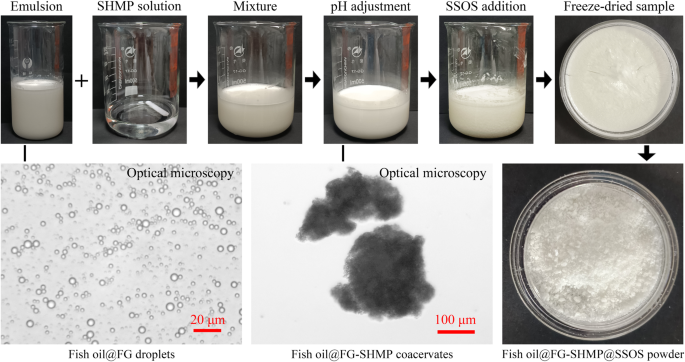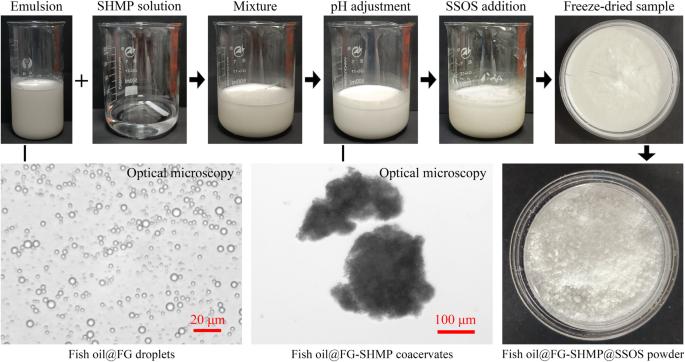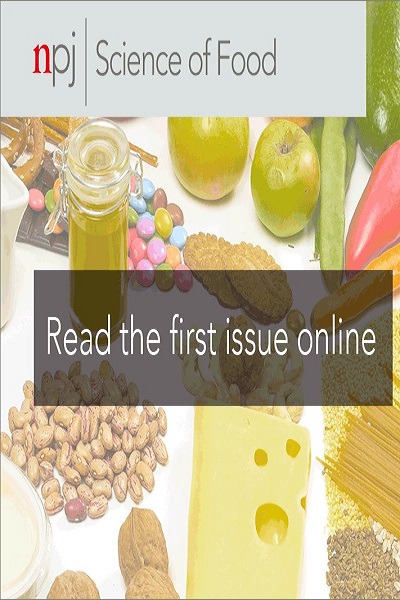Effects of gelatin type and concentration on the preparation and properties of freeze-dried fish oil powders
IF 6.3
1区 农林科学
Q1 FOOD SCIENCE & TECHNOLOGY
引用次数: 0
Abstract
The effects of gelatin type (porcine skin gelatin, PSG; bovine skin gelatin, BSG; fish gelatin, FG; or cold-water fish skin gelatin, CFG) and concentration on the preparation and properties of fish oil powders were investigated in this work. The oil powders were prepared using the combination method of gelatin-sodium hexametaphosphate complex coacervation with starch sodium octenyl succinate (SSOS)-aided freeze-drying. Compared with the other gelatins, CFG—with an unobvious isoelectric point, a lower molecular weight, more hydrogen bonds, and longer gel formation time—could not form complex coacervates, which are necessary to prepare oil powders. For oil powders obtained from the other gelatins, gelatin type and concentration did not have obvious effects on microscale morphologies; they did, however, have significant effects on physicochemical properties. The highest peroxide values of the oil powders were mainly dependent on the gelatins, expressed in the following manner: PSG (153 ± 5 – 168 ± 3 meq/Kg oil) < BSG (176 ± 5 – 188 ± 1 meq/Kg oil) < FG (196 ± 11 – 201 ± 22 meq/Kg oil). Acidic and neutral pH could not dissolve the complex coacervates. However, the oil powders could be quickly dissolved to form emulsion droplets in the gastric phase, and that SSOS increased coacervate stability and promoted oil digestion during the in vitro gastrointestinal process. In sum, this study contributes fundamental information to understanding the development of fish oil solid encapsulation preparations.


明胶类型和浓度对冻干鱼油粉的制备和特性的影响
这项工作研究了明胶类型(猪皮明胶,PSG;牛皮明胶,BSG;鱼皮明胶,FG;或冷水鱼皮明胶,CFG)和浓度对鱼油粉末的制备和性能的影响。鱼油粉末的制备采用明胶-六偏磷酸钠复合物共凝胶与淀粉辛烯基琥珀酸钠(SSOS)辅助冷冻干燥相结合的方法。与其他明胶相比,CFG 的等电点不明显,分子量较低,氢键较多,凝胶形成时间较长,因此无法形成制备油粉所需的复合共凝胶。对于用其他明胶制备的油粉,明胶类型和浓度对微观形态没有明显影响,但对理化性质有显著影响。油粉的最高过氧化值主要取决于明胶,具体表现如下:PSG(153 ± 5 - 168 ± 3 meq/Kg油);BSG(176 ± 5 - 188 ± 1 meq/Kg油);FG(196 ± 11 - 201 ± 22 meq/Kg油)。酸性和中性 pH 值无法溶解复合共凝胶。然而,油粉在胃相中可迅速溶解形成乳状液滴,而且在体外胃肠道过程中,SSOS 提高了共凝胶的稳定性并促进了油的消化。总之,这项研究为了解鱼油固态封装制剂的开发提供了基础信息。
本文章由计算机程序翻译,如有差异,请以英文原文为准。
求助全文
约1分钟内获得全文
求助全文
来源期刊

NPJ Science of Food
FOOD SCIENCE & TECHNOLOGY-
CiteScore
7.50
自引率
1.60%
发文量
53
期刊介绍:
npj Science of Food is an online-only and open access journal publishes high-quality, high-impact papers related to food safety, security, integrated production, processing and packaging, the changes and interactions of food components, and the influence on health and wellness properties of food. The journal will support fundamental studies that advance the science of food beyond the classic focus on processing, thereby addressing basic inquiries around food from the public and industry. It will also support research that might result in innovation of technologies and products that are public-friendly while promoting the United Nations sustainable development goals.
 求助内容:
求助内容: 应助结果提醒方式:
应助结果提醒方式:


